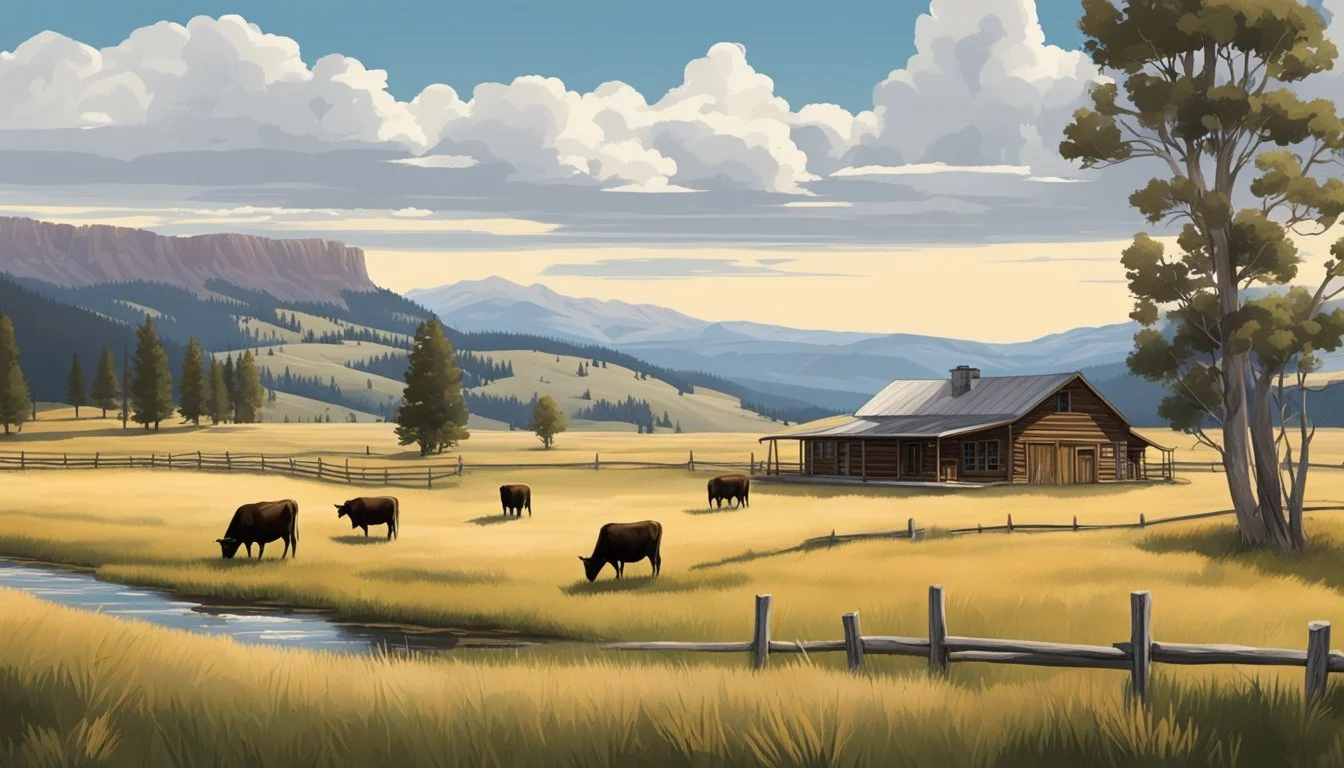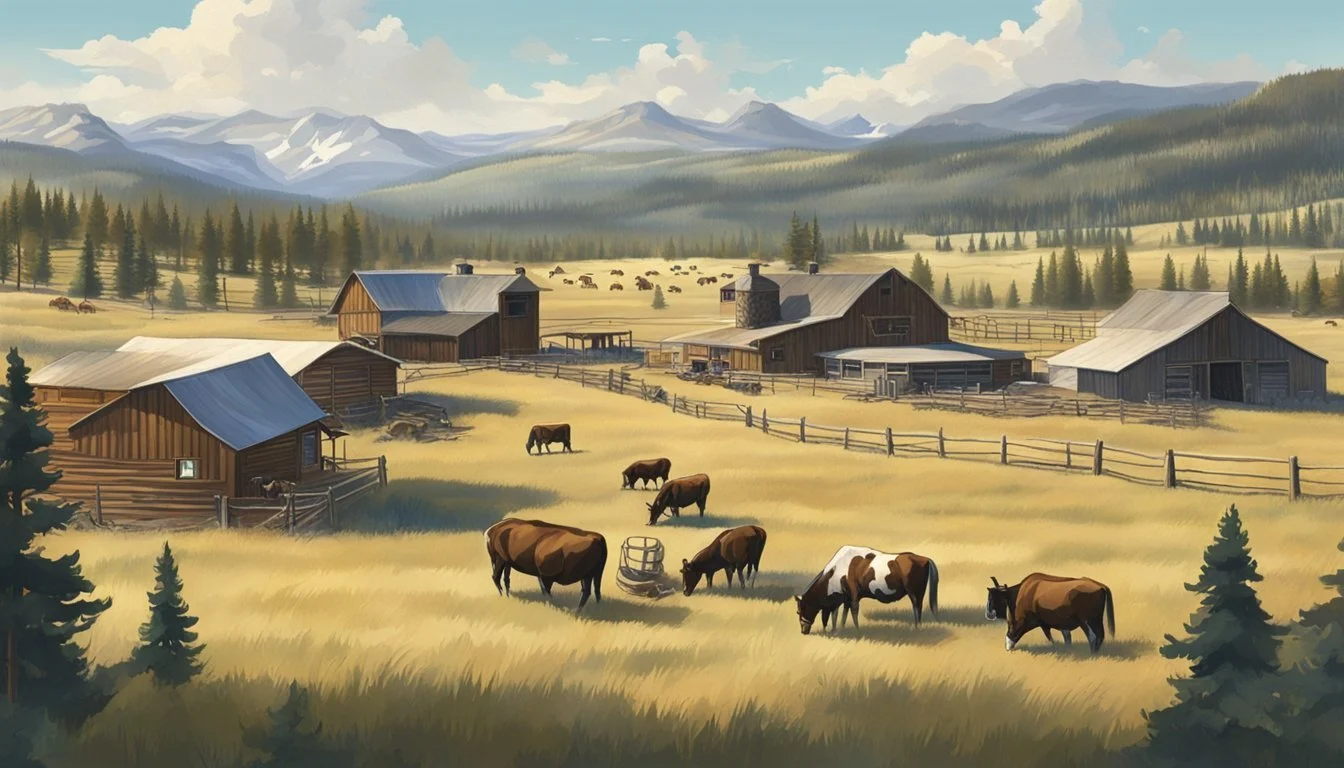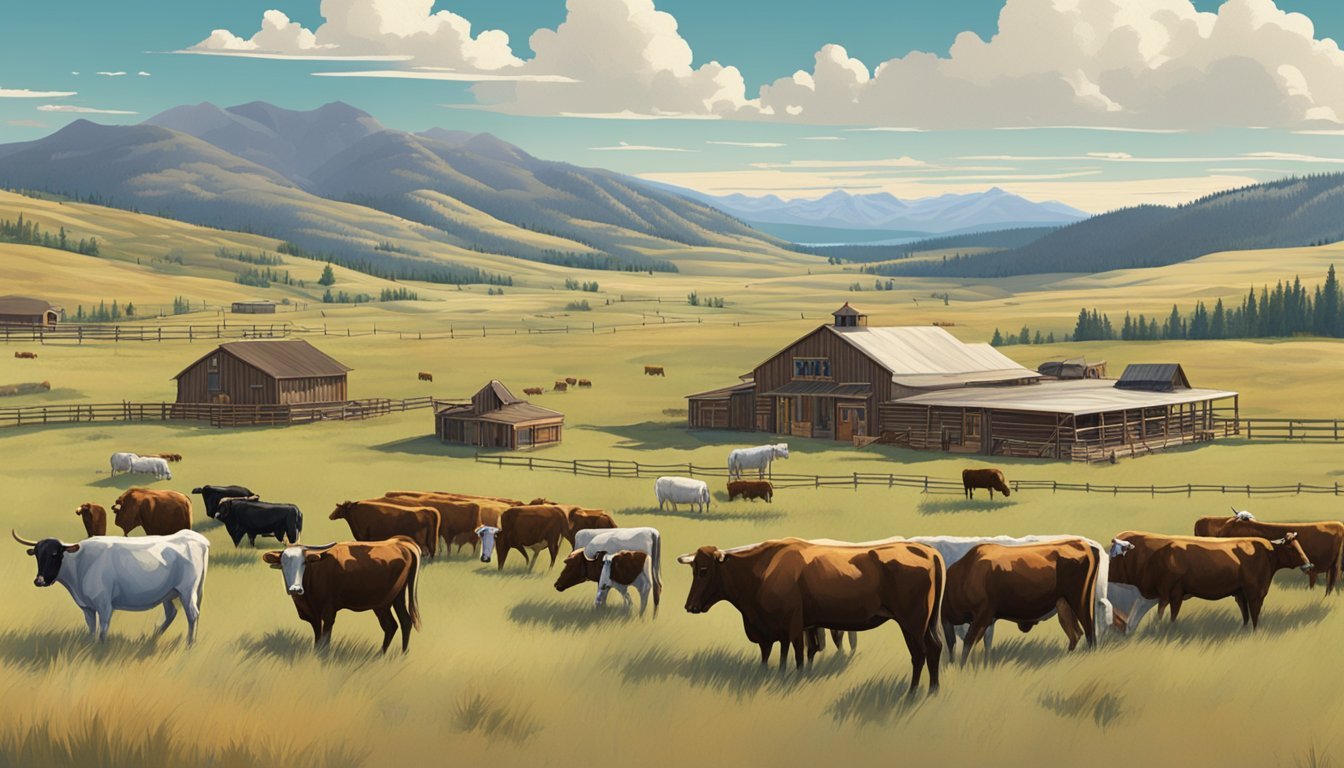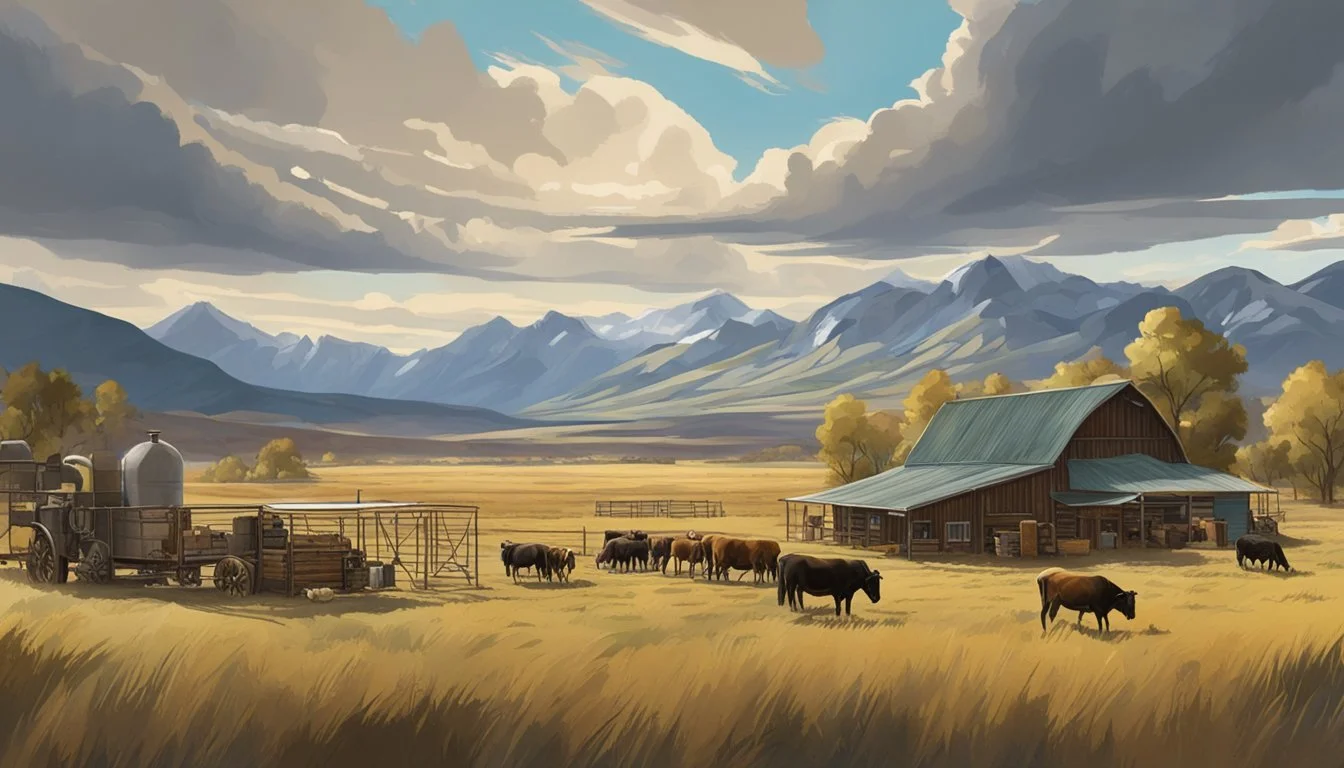Yellowstone's Depiction of Modern Ranching Challenges in Montana
Reality vs. Fiction on the Small Screen
Yellowstone, the hit television series created by Taylor Sheridan, has captivated audiences with its dramatic portrayal of ranch life in Montana. The show's depiction of modern ranching challenges has sparked conversations about the realities faced by actual ranchers in the region.
While Yellowstone offers a romanticized view of ranching, it also highlights genuine issues confronting Montana's agricultural community, including land disputes, economic pressures, and environmental concerns. The series taps into the state's complex history, including its settlement by Confederates and ex-Confederates, adding layers to its narrative.
Yellowstone's popularity has contributed to a shift in Montana's ranching landscape. The show's portrayal of ranch life has attracted newcomers to the state, influencing property values and altering the dynamics of long-established ranching communities. This intersection of fiction and reality underscores the impact media can have on shaping perceptions and even transforming local economies.
Historical Context of Ranching in Montana
Ranching has been integral to Montana's economy and culture since the late 19th century. The industry's evolution reflects broader changes in technology, transportation, and land use across the American West.
Origins and Evolution of Ranching
Montana's ranching history began in the 1860s as pioneers moved westward. The Northern Pacific Railroad's arrival in 1881 transformed the industry, enabling efficient livestock transport to eastern markets. In 1884, the Montana Stockgrowers' Association formed, signaling the industry's growing importance.
Open range grazing dominated early practices. Ranchers utilized vast public lands to feed their herds. This era saw the rise of iconic cattle drives and cowboy culture.
The harsh winter of 1886-1887 devastated many operations, leading to changes in ranching methods. Fenced pastures and hay production became more common to protect livestock.
Impact of '1883' on Public Perception
The TV series "1883" has rekindled interest in Montana's ranching origins. It portrays the challenges faced by early settlers and cattle drivers.
The show highlights the rugged landscape and harsh conditions that shaped ranching practices. It depicts the conflicts between indigenous peoples, homesteaders, and ranchers during territorial expansion.
"1883" romanticizes certain aspects of frontier life, potentially influencing modern perceptions of ranching history. This dramatization has sparked tourism interest in Montana's historical ranching sites.
Transformation from '1923' to Modern Days
The period around 1923 marked significant changes in Montana ranching. Mechanization began to replace horse-powered operations. Improved breeding techniques and veterinary care increased herd productivity.
The Dust Bowl of the 1930s forced many ranchers to adopt soil conservation practices. World War II brought increased demand for beef, boosting the industry.
Post-war years saw further modernization with the introduction of tractors and advanced irrigation systems. Today, Montana ranches face new challenges, including climate change and competition for land use.
Modern ranching operations balance traditional practices with technological innovations. Many ranches have diversified, incorporating tourism and conservation efforts to remain viable in the 21st century.
The Dutton Family Saga
The Dutton family's story forms the heart of Yellowstone, weaving together themes of legacy, power, and the struggle to maintain a way of life. Their multi-generational saga captures the essence of modern ranching challenges in Montana.
Character Analysis: John Dutton Portrayed by Kevin Costner
Kevin Costner brings gravitas to the role of John Dutton, the patriarch of the Dutton family. As a sixth-generation rancher, John embodies the traditional values of the American West. His character is a complex mix of ruthless businessman and devoted father.
John's unwavering commitment to preserving his family's legacy often puts him at odds with progress and change. This internal conflict drives much of the show's tension. Costner's portrayal highlights John's stoicism and determination in the face of numerous threats to his land and livelihood.
The character's moral ambiguity adds depth to the narrative. John's actions, while often questionable, are rooted in his desire to protect what he sees as his birthright.
Dutton Ranch: Symbol of Legacy and Stewardship
The Yellowstone Dutton Ranch serves as more than just a setting; it's a character in its own right. This vast property represents the Dutton family's history and future. The ranch's expanse mirrors the scope of John Dutton's influence and power in the region.
As the largest contiguous ranch in the United States, Yellowstone faces constant pressure from developers, government agencies, and neighboring Native American reservations. These conflicts reflect real-world issues facing many large landowners in Montana.
The ranch's day-to-day operations provide insight into modern cattle farming practices. From branding to range management, the show depicts the challenges of maintaining a working ranch in the 21st century.
Family Drama and Power Struggles: A Narrative Engine
Internal family dynamics drive much of Yellowstone's plot. The Dutton children - Jamie, Beth, and Kayce - each represent different aspects of the ranching lifestyle and its future. Their conflicting loyalties and ambitions create a web of intrigue within the family.
Beth's fierce loyalty contrasts with Jamie's political ambitions, while Kayce struggles to balance his family obligations with his ties to the nearby reservation. These interpersonal conflicts mirror larger themes of tradition versus progress.
Power struggles within the family often reflect broader political and economic battles in Montana. The show uses these personal dramas to explore issues of land use, resource management, and the changing face of the American West.
Environmental and Economic Challenges of Modern Ranching
Montana ranchers face complex environmental and economic pressures in today's rapidly changing landscape. Balancing traditional practices with modern demands requires adaptability and innovation.
Cattle Drives and Land Management
Cattle drives remain an integral part of Montana ranching, though methods have evolved. Ranchers now use helicopters and GPS technology to efficiently move herds across vast landscapes. This modernization helps manage grazing patterns and minimize environmental impact.
Land management practices focus on soil health and grassland preservation. Rotational grazing systems allow pastures to recover, promoting biodiversity and preventing overgrazing. Ranchers work to maintain delicate ecosystems while maximizing cattle production.
Water conservation is crucial in Montana's semi-arid climate. Many ranches implement efficient irrigation systems and protect riparian areas to ensure sustainable water use for both livestock and wildlife.
Tension with Developers and Conservation Efforts
Urban expansion and resort development create pressure on ranch lands. Developers offer high prices for scenic properties, tempting cash-strapped ranchers to sell. This leads to fragmentation of open spaces and wildlife habitats.
Conservation easements provide an alternative, allowing ranchers to protect their land from development while retaining ownership. These agreements often include financial incentives and tax benefits.
Conflicts arise between ranchers and environmental groups over issues like predator management and public land use. Collaborative efforts seek compromise, balancing ranching needs with wildlife conservation goals.
Economic Realities: Profitability and Sustainability
Montana ranchers face tight profit margins due to fluctuating cattle prices and rising operational costs. Many diversify income streams through agritourism, specialty meat products, or leasing land for recreation.
Sustainable ranching practices can improve long-term profitability. Grass-finished beef commands premium prices in niche markets. Some ranchers explore carbon credit programs, earning income for sequestering carbon in grasslands.
Labor shortages pose challenges for ranch operations. Attracting and retaining skilled workers in remote areas requires competitive wages and benefits. Some ranches partner with agricultural education programs to cultivate future ranchers and ranch managers.
Cultural Portrayal and Public Sentiment
The TV show "Yellowstone" has profoundly shaped public perceptions of modern ranching in Montana. Its dramatic portrayal of ranch life blends fact and fiction, influencing viewers' understanding of the industry's challenges and cultural significance.
Influence of 'Yellowstone' on Public Views
"Yellowstone" has become a cultural phenomenon, sparking conversations about ranching, land ownership, and Western values. The show's popularity has led to increased interest in Montana's landscapes and lifestyle. Many viewers have formed opinions about ranching based on the Dutton family's experiences, despite the show's dramatized nature.
The series highlights conflicts between traditional ranching culture and modern pressures like corporate development. This has raised awareness of real-world issues facing Montana ranchers, including land disputes and environmental concerns.
Ranching as Represented on Screen
"Yellowstone" portrays ranching as a high-stakes endeavor fraught with family drama and power struggles. While exaggerated for television, this depiction contains elements of truth. The show accurately captures the challenges of maintaining large, family-owned ranches in the face of economic pressures and changing land use.
The series also showcases the beauty of ranch work, from cattle drives to horseback riding across vast landscapes. This romanticized view has contributed to a renewed interest in Western culture and lifestyle among viewers.
Tourism and Ranching: Coexistence or Conflict?
The show's popularity has led to a surge in tourism to Montana, particularly areas near Yellowstone National Park. This influx has created both opportunities and challenges for local ranchers. Some have benefited from increased interest in ranch experiences and Western-themed tourism.
However, the growth in visitors has also led to concerns about land use and preservation. Ranchers face pressure to balance their traditional practices with the demands of a tourism-driven economy. The show indirectly highlights this tension, depicting the Dutton ranch as a coveted piece of land desired by developers and conservationists alike.
The Role of Relationships in Ranching Narratives
Relationships form the core of ranching stories, shaping both personal dynamics and business decisions. They provide emotional depth and drive conflicts that keep audiences engaged.
Friends and Allies: Building a Support Network
Ranchers rely heavily on trusted friends and allies to navigate challenges. The Dutton family in Yellowstone exemplifies this, with John Dutton cultivating a network of loyal ranch hands and local officials. These relationships prove crucial during land disputes and financial crises. Mutual support among neighboring ranchers is common, as they share resources and expertise. Family bonds are often tested but ultimately strengthened through adversity. Ranch hands become like extended family, working closely together and developing deep loyalties.
Antagonists and Allies: Crafting Compelling Conflicts
Power struggles and family drama fuel many ranching narratives. In Yellowstone, the Duttons face threats from developers, rival ranchers, and even internal family conflicts. These antagonistic relationships create tension and drive the plot forward. Alliances shift as characters navigate complex political and economic landscapes. Business partnerships can turn sour, leading to dramatic confrontations. Family members may disagree on ranch management, causing rifts that threaten the legacy. External pressures from changing markets or government regulations often force ranchers to form unexpected alliances or face formidable opponents.
Taylor Sheridan's Vision and Contributions
Taylor Sheridan's creative genius and commitment to authenticity have shaped Yellowstone into a groundbreaking television series that reinvents the Western genre. His vision captures the essence of modern ranching in Montana while exploring complex family dynamics and power struggles.
Creative Process and Inspiration
Sheridan envisioned Yellowstone as a modern-day Montana version of The Godfather. He aimed to create a powerful family drama set against the backdrop of a vast ranch. This unique concept blends traditional Western elements with contemporary challenges faced by ranchers.
Sheridan fought to cast Kevin Costner as John Dutton, recognizing the actor's ability to embody the character's strength and complexity. This decision proved crucial in bringing Sheridan's vision to life on screen.
The creator drew inspiration from his own experiences and observations of the American West. His deep understanding of ranching culture and the region's social dynamics infuses the show with authenticity.
Authenticity and Storytelling in 'Yellowstone'
Sheridan's commitment to authenticity sets Yellowstone apart from traditional Westerns. He meticulously portrays the realities of modern ranching, including land disputes, political conflicts, and economic pressures.
The series delves into the complexities of family relationships and power dynamics within the Dutton clan. Sheridan's nuanced storytelling explores themes of loyalty, legacy, and the struggle to maintain a way of life in a changing world.
Yellowstone's success has led to the expansion of Sheridan's creative universe. The show's popularity has spawned spin-offs and prequels, further exploring the rich tapestry of characters and stories within this world.
Sheridan's portrayal of American masculinity in Yellowstone resonates with viewers. He presents complex male characters who grapple with traditional values and modern challenges.
Conclusion
Yellowstone offers a compelling yet dramatized portrayal of modern ranching in Montana. The show highlights real challenges while taking creative liberties for entertainment.
Summary of Modern Ranching Insights
Yellowstone accurately depicts some key issues facing Montana ranchers today. Land disputes, economic pressures, and conflicts with developers are real concerns. The show also captures the strong sense of tradition and connection to the land.
Taylor Sheridan's ranching background lends authenticity to certain aspects. The series showcases genuine ranching practices and equipment. However, it exaggerates the violence and power dynamics for dramatic effect.
The romanticized portrayal has influenced public perceptions of ranching. This has led to increased interest in Montana ranch properties among wealthy outsiders.
Future Prospects for Ranching in Media and Reality
Yellowstone's popularity may inspire more ranch-focused media. Future productions could explore ranching challenges with greater realism. There's potential for documentaries or series that delve deeper into the economic and environmental realities.
In Montana, the ranching industry faces ongoing changes. Climate change, water scarcity, and market fluctuations pose significant challenges. Adaptation and innovation will be crucial for ranchers to thrive.
The show's impact on Montana's ranching landscape may continue. It could attract more non-traditional buyers to the state. This trend may reshape land ownership patterns and local communities.







